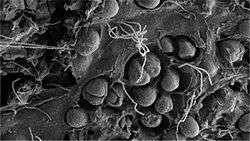Plastisphere


Plastisphere is a term used to refer to ecosystems that have evolved to live in human-made plastic environments.
Plastic that has made its way into marine habitats has been found to host various microorganisms. The hydrophobic nature of plastic surfaces stimulates rapid formation of biofilms,[1] which support a wide range of metabolic activities, and drive succession of other micro- and macro-organisms.[2] A recent study identified more than 1,000 species of bacteria and algae attached to microplastic debris, including members of the genus Vibrio, a genus which includes the bacteria that cause cholera and other gastrointestinal ailments. Some of these bacteria glow and it is hypothesized that this attracts fish that eat the organisms colonizing the plastic, which then feed from the stomachs of the fish.[3]
Plastic pollution provides a more durable "ship" than biodegradable material for carrying the organisms over long distances.[4] This long distance transportation can move microbes to different ecosystems and potentially introduce invasive species[5] as well as harmful algae.[6] The microorganisms found on the plastic debris include autotrophs, heterotrophs and symbionts.[7] The ecosystem created by the plastisphere differs from other floating materials that naturally occur (i.e., feathers and algae) due to the slow speed of biodegradation and other different conditions.
Some of the organisms are thought to accelerate the biodegradation of plastic materials into potentially hazardous chemicals.[4] This could be potentially advantageous though, as scientists may be able to utilize the microbes to break down plastic that would otherwise remain intact longer.[8] On the other hand, as plastic is broken down into smaller pieces and eventually microplastics, there is a higher likelihood that it will be consumed by plankton and enter into the food chain.[9] As plankton are eaten by larger organisms, the plastic may eventually accumulate in fish eaten by humans.[9]
In addition to microbes, insects have come to flourish in areas of the ocean that they previously could not. The sea skater, for example, has been able to reproduce on the hard surface provided by the floating plastic.[8]
Research
The Plastisphere was first described by Dr. Linda Amaral-Zettler from the Marine Biological Laboratory, Dr. Tracy Mincer from Woods Hole Oceanographic Institution and Dr. Erik Zettler from Sea Education Association. They collected plastic samples during research trips of the Sea Education Association to study "what kinds of microbes live in the plastisphere, how they colonize the surfaces of plastic, and how they might affect marine ecosystems".[5] They analyzed plastic fragments collected in nets from multiple locations within the Atlantic Ocean.[6] The researchers used scanning electron micrographs to determine what was colonizing the plastic surface.[5] "Pit formers" were among the most notable finds. The researchers speculate that these "pit formers" help to accelerate the biodegradation and form crevices where other microorganisms can colonize.[5] Moreover, they may also have the potential to break down hydrocarbons.[6] Using a "combination of high-powered microscopy and state-of-the-art DNA sequencing," the researchers were able to identify thousands of diverse organisms that were distinct from the "natural" environment.[9]
See also
References
- ↑ "Millimeter-Sized Marine Plastics: A New Pelagic Habitat for Microorganisms and Invertebrates". PLoS ONE. PLoS ONE. 9: e100289. 18 June 2014. doi:10.1371/journal.pone.0100289. Retrieved 2015-09-27.
- ↑ Davet, ME; O'Toole, GA (2000), "Microbial biofilms: from ecology to molecular genetics", Microbiology and Molecular Biology Reviews, 64: 847–867, doi:10.1128/MMBR.64.4.847-867.2000, PMC 99016
 , PMID 11104821
, PMID 11104821 - ↑ "Glowing Bugs May Lure Fish in the 'Plastisphere' - NBC News". NBC News. Retrieved 2015-11-14.
- 1 2 Sahagun, Louis (2013-12-26). "An ecosystem of our own making could pose a threat". latimes.com. Retrieved 2014-01-13.
- 1 2 3 4 "The "Plastisphere:" A new marine ecosystem". Retrieved 2015-09-27.
- 1 2 3 "Behold the 'Plastisphere' | Ocean Leadership". Consortium for Ocean Leadership. Retrieved 2015-11-18.
- ↑ "Scientists Discover Thriving Colonies of Microbes in Ocean 'Plastisphere'". Woods Hole Oceanographic Institution. Retrieved 2015-09-27.
- 1 2 "Our Trash Has Become A New Ocean Ecosystem Called "The Plastisphere"". Gizmodo. Retrieved 2015-10-20.
- 1 2 3 "Welcome to The Plastisphere: ocean-going microbes on vessels of plastic". The Conversation. Retrieved 2015-11-14.
Sources
- Zettler, Erik R.; Mincer, Tracy J.; Amaral-Zettler, Linda A. (19 June 2013). "Life in the "Plastisphere": Microbial Communities on Plastic Marine Debris". Environmental Science & Technology: 130619162220002. doi:10.1021/es401288x.
- Stay informed today and every day (2013-07-20). "Marine ecology: Welcome to the plastisphere". The Economist. Retrieved 2014-01-13.
- "Plastisphere microbes go to sea on flotsam fragments – environment – 02 July 2013". New Scientist. Retrieved 2014-01-13.
- 11/13/13 3:40pm 11/13/13 3:40pm. "New life found on plastic waste gives rise to the 'plastisphere'". Io9.com. Retrieved 2014-01-13.